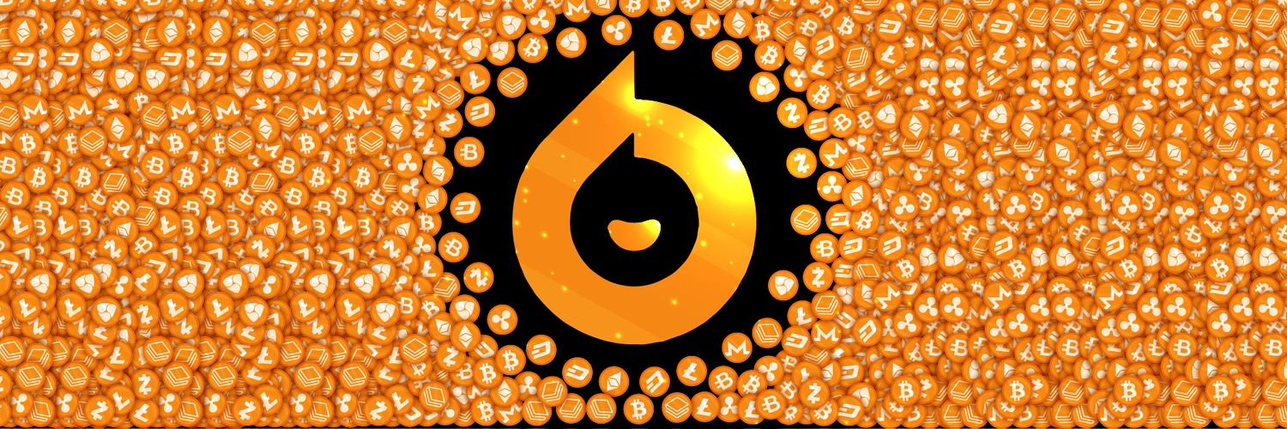Bitget:日次取引量の世界ランキングでトップ4にランクイン!
BTCマーケットシェア63.64%
Bitgetの新規上場: Blum
ビットコイン半減期:2024年,2028年
BTC/USDT$119424.03 (+0.05%)恐怖・強欲指数73(強欲)
アルトコインシーズン指数:0(ビットコインシーズン)
ビットコイン現物ETFの純流入総額(+$1.03B(1日)、+$3.31B(7日))。6,200 USDT相当の新規ユーザー向けウェルカムギフトパッケージ。今すぐ獲得する
Bitgetアプリでいつでもどこでも取引しましょう今すぐダウンロードする
Bitget:日次取引量の世界ランキングでトップ4にランクイン!
BTCマーケットシェア63.64%
Bitgetの新規上場: Blum
ビットコイン半減期:2024年,2028年
BTC/USDT$119424.03 (+0.05%)恐怖・強欲指数73(強欲)
アルトコインシーズン指数:0(ビットコインシーズン)
ビットコイン現物ETFの純流入総額(+$1.03B(1日)、+$3.31B(7日))。6,200 USDT相当の新規ユーザー向けウェルカムギフトパッケージ。今すぐ獲得する
Bitgetアプリでいつでもどこでも取引しましょう今すぐダウンロードする
Bitget:日次取引量の世界ランキングでトップ4にランクイン!
BTCマーケットシェア63.64%
Bitgetの新規上場: Blum
ビットコイン半減期:2024年,2028年
BTC/USDT$119424.03 (+0.05%)恐怖・強欲指数73(強欲)
アルトコインシーズン指数:0(ビットコインシーズン)
ビットコイン現物ETFの純流入総額(+$1.03B(1日)、+$3.31B(7日))。6,200 USDT相当の新規ユーザー向けウェルカムギフトパッケージ。今すぐ獲得する
Bitgetアプリでいつでもどこでも取引しましょう今すぐダウンロードする


Smart Game Financeの価格SMART
JPY
上場済み
$0.004555JPY
+8.86%1D
本日00:44(UTC)時点のSmart Game Finance(SMART)価格は換算で$0.004555 JPYです。
SMARTからJPYへの交換
SMART
JPY
1 SMART = 0.004555 JPY.現在の1 Smart Game Finance(SMART)からJPYへの交換価格は0.004555です。レートはあくまで参考としてご活用ください。更新されました。
Bitgetは、主要取引プラットフォームの中で最も低い取引手数料を提供しています。VIPレベルが高ければ高いほど、より有利なレートが適用されます。
Smart Game Financeの価格チャート(JPY/SMART)
最終更新:2025-07-15 00:44:42(UTC+0)
時価総額:--
完全希薄化の時価総額:--
24時間取引量:$222,430.47
24時間取引量 / 時価総額:0.00%
24時間高値:$0.005895
24時間安値:$0.005114
過去最高値:$9.68
過去最安値:$0.{4}8681
循環供給量:-- SMART
総供給量:
622,080,000SMART
流通率:0.00%
最大供給量:
--SMART
BTCでの価格:0.{7}3800 BTC
ETHでの価格:0.{5}1509 ETH
BTC時価総額での価格:
--
ETH時価総額での価格:
--
コントラクト:
0xce20...819ad8c(Ethereum)
本日のSmart Game Financeの現在価格(JPY)
現在、Smart Game Financeの価格は$0.004555 JPYで時価総額は$0.00です。Smart Game Financeの価格は過去24時間で8.86%上昇し、24時間の取引量は$222,430.47です。SMART/JPY(Smart Game FinanceからJPY)の交換レートはリアルタイムで更新されます。
1 Smart Game Financeは換算でいくらですか?
現在のSmart Game Finance(SMART)価格は換算で$0.004555 JPYです。現在、1 SMARTを$0.004555、または2,195.54 SMARTを$10で購入できます。過去24時間のSMARTからJPYへの最高価格は$0.005895 JPY、SMARTからJPYへの最低価格は$0.005114 JPYでした。
Smart Game Financeの価格は今日上がると思いますか、下がると思いますか?
総投票数:
上昇
0
下落
0
投票データは24時間ごとに更新されます。これは、Smart Game Financeの価格動向に関するコミュニティの予測を反映したものであり、投資アドバイスと見なされるべきではありません。
Smart Game Finance (SMART)について
スマートゲームファイナンストークン:ブロックチェーンとゲームの未来
スマートゲームファイナンス(Smart Game Finance)は、ゲームとブロックチェーンテクノロジーの世界を革新的に統合する仮想通貨です。このトークンは、グローバルなゲーム市場の成長とブロックチェーンの可能性を最大限に引き出すことを目指しています。
スマートゲームファイナンストークンの特徴
ゲーム業界へのイノベーション
スマートゲームファイナンスは、ゲームの進化を促進することで名高いです。トークンはブロックチェーン技術をゲーム業界に導入することにより、価値の生成と共有、透明性と公平性の向上を目指しています。
ブロックチェーンの活用
ブロックチェーン技術の利点を最大限に活用することで、スマートゲームファイナンスはゲームプレーヤーと開発者の間のリレーションシップを強化しています。トランザクションは透明であり、ゲーム内のアイテムの所有権と交換が容易になります。
スマートゲームファイナンストークンの歴史的意義
スマートゲームファイナンスは、ゲームとブロックチェーンの融合という新しいトレンドを代表するものとして注目を集めています。その歴史的重要性は、これら二つの大きな産業がどのように連携し、相互に利点を生み出すことができるかを示しています。
最終的に、スマートゲームファイナンストークンは、ブロックチェーンとゲームの融合により、全く新しいゲーム体験を作り出すことができる未来を提示しています。このトークンは、世界中のゲーム業界が次世代のインターネットエコノミーにどのように対応するかを示すモデルとなりつつあります。
Smart Game FinanceのAI分析レポート
本日の暗号資産市場のハイライトレポートを見る
Smart Game Financeの価格履歴(JPY)
Smart Game Financeの価格は、この1年で+127.47%を記録しました。直近1年間のJPY建てSMARTの最高値は$0.007374で、直近1年間のJPY建てSMARTの最安値は$0.0006294でした。
時間価格変動率(%) 最低価格
最低価格 最高価格
最高価格 
 最低価格
最低価格 最高価格
最高価格 
24h+8.86%$0.005114$0.005895
7d+194.82%$0.001906$0.007374
30d+589.75%$0.0006294$0.007374
90d+278.91%$0.0006294$0.007374
1y+127.47%$0.0006294$0.007374
すべての期間-99.83%$0.{4}8681(2023-11-22, 1年前 )$9.68(2023-02-17, 2年前 )
Smart Game Financeの最高価格はいくらですか?
SMARTの過去最高値(ATH)は$9.68 JPYで、2023-02-17に記録されました。SMARTのATHと比較すると、SMARTの現在価格はSmart Game Finance下落しています。
Smart Game Financeの最安価格はいくらですか?
SMARTの過去最安値(ATL)は$0.{4}8681 JPYで、2023-11-22に記録されました。SMARTのATLと比較すると、SMARTの現在価格はSmart Game Finance上昇しています。
Smart Game Financeの価格予測
SMARTの買い時はいつですか? 今は買うべきですか?それとも売るべきですか?
SMARTを買うか売るかを決めるときは、まず自分の取引戦略を考える必要があります。長期トレーダーと短期トレーダーの取引活動も異なります。BitgetSMARTテクニカル分析は取引の参考になります。
SMART4時間ごとのテクニカル分析によると取引シグナルは強い買い推奨です。
SMART1日ごとのテクニカル分析によると取引シグナルは購入です。
SMART1週間ごとのテクニカル分析によると取引シグナルは購入です。
2026年のSMARTの価格はどうなる?
SMARTの過去の価格パフォーマンス予測モデルによると、SMARTの価格は2026年に$0.005082に達すると予測されます。
2031年のSMARTの価格はどうなる?
2031年には、SMARTの価格は+11.00%変動する見込みです。 2031年末には、SMARTの価格は$0.01298に達し、累積ROIは+185.68%になると予測されます。
注目のキャンペーン
よくあるご質問
Smart Game Financeの現在の価格はいくらですか?
Smart Game Financeのライブ価格は$0(SMART/JPY)で、現在の時価総額は$0 JPYです。Smart Game Financeの価値は、暗号資産市場の24時間365日休みない動きにより、頻繁に変動します。Smart Game Financeのリアルタイムでの現在価格とその履歴データは、Bitgetで閲覧可能です。
Smart Game Financeの24時間取引量は?
過去24時間で、Smart Game Financeの取引量は$222,430.47です。
Smart Game Financeの過去最高値はいくらですか?
Smart Game Finance の過去最高値は$9.68です。この過去最高値は、Smart Game Financeがローンチされて以来の最高値です。
BitgetでSmart Game Financeを購入できますか?
はい、Smart Game Financeは現在、Bitgetの取引所で利用できます。より詳細な手順については、お役立ちsmart-game-financeの購入方法 ガイドをご覧ください。
Smart Game Financeに投資して安定した収入を得ることはできますか?
もちろん、Bitgetは戦略的取引プラットフォームを提供し、インテリジェントな取引Botで取引を自動化し、利益を得ることができます。
Smart Game Financeを最も安く購入できるのはどこですか?
戦略的取引プラットフォームがBitget取引所でご利用いただけるようになりました。Bitgetは、トレーダーが確実に利益を得られるよう、業界トップクラスの取引手数料と流動性を提供しています。
Smart Game Financeの集中度別保有量
大口
投資家
リテール
Smart Game Financeの保有時間別アドレス
長期保有者
クルーザー
トレーダー
coinInfo.name(12)のリアル価格チャート

Smart Game Financeのグローバル価格
現在、Smart Game Financeは他の通貨の価値でいくらですか?最終更新:2025-07-15 00:44:42(UTC+0)
SMART から MXN
Mexican Peso
Mex$0.09SMART から GTQGuatemalan Quetzal
Q0.03SMART から CLPChilean Peso
CLP$4.41SMART から UGXUgandan Shilling
Sh16.32SMART から HNLHonduran Lempira
L0.12SMART から ZARSouth African Rand
R0.08SMART から TNDTunisian Dinar
د.ت0.01SMART から IQDIraqi Dinar
ع.د5.97SMART から TWDNew Taiwan Dollar
NT$0.13SMART から RSDSerbian Dinar
дин.0.46SMART から DOPDominican Peso
RD$0.27SMART から MYRMalaysian Ringgit
RM0.02SMART から GELGeorgian Lari
₾0.01SMART から UYUUruguayan Peso
$0.19SMART から MADMoroccan Dirham
د.م.0.04SMART から AZNAzerbaijani Manat
₼0.01SMART から OMROmani Rial
ر.ع.0SMART から KESKenyan Shilling
Sh0.59SMART から SEKSwedish Krona
kr0.04SMART から UAHUkrainian Hryvnia
₴0.19- 1
- 2
- 3
- 4
- 5
今日の暗号資産価格
Bitgetに新規上場された通貨の価格
新規上場
Smart Game Finance(SMART)の購入方法

無料でBitgetアカウントを作成します
Eメールアドレス/携帯電話番号でBitgetに登録し、アカウントを保護するために強力なパスワードを作成します。

アカウントを認証する
個人情報を入力し、有効な写真付き身分証明書をアップロードして本人確認(KYC認証)を行います。

SMARTをJPYに交換
Bitgetで取引する暗号資産を選択します。
詳細はこちらもっと購入する
Smart Game Finance(SMART)はどこで買えますか?
動画セクション - 素早く認証を終えて、素早く取引へ

Bitgetで本人確認(KYC認証)を完了し、詐欺から身を守る方法
1. Bitgetアカウントにログインします。
2. Bitgetにまだアカウントをお持ちでない方は、アカウント作成方法のチュートリアルをご覧ください。
3. プロフィールアイコンにカーソルを合わせ、「未認証」をクリックし、「認証する」をクリックしてください。
4. 発行国または地域と身分証の種類を選択し、指示に従ってください。
5. 「モバイル認証」または「PC」をご希望に応じて選択してください。
6. 個人情報を入力し、身分証明書のコピーを提出し、自撮りで撮影してください。
7. 申請書を提出すれば、本人確認(KYC認証)は完了です。
Bitgetを介してオンラインでSmart Game Financeを購入することを含む暗号資産投資は、市場リスクを伴います。Bitgetでは、簡単で便利な購入方法を提供しており、取引所で提供している各暗号資産について、ユーザーに十分な情報を提供するよう努力しています。ただし、Smart Game Financeの購入によって生じる結果については、当社は責任を負いかねます。このページおよび含まれる情報は、特定の暗号資産を推奨するものではありません。
SMARTからJPYへの交換
SMART
JPY
1 SMART = 0.004555 JPY.現在の1 Smart Game Finance(SMART)からJPYへの交換価格は0.004555です。レートはあくまで参考としてご活用ください。更新されました。
Bitgetは、主要取引プラットフォームの中で最も低い取引手数料を提供しています。VIPレベルが高ければ高いほど、より有利なレートが適用されます。
Smart Game Financeの評価
コミュニティからの平均評価
4.4
このコンテンツは情報提供のみを目的としたものです。
Bitgetインサイト

Eli5DeFi
2025/05/30 03:50
Tagged my friends to check @stayloudio - $LOUD
> @HouseofChimera
> @stacy_muur
> @belizardd
> @SherifDefi
> @0xCheeezzyyyy
> @moic_digital
> @Mars_DeFi
> @Nick_Researcher
> @YashasEdu
> @thelearningpill
> @kenodnb
> @Flowslikeosmo
> @AlwaysBeenChoze
> @satyaXBT
> @Haylesdefi
> @Hercules_Defi
> @DeRonin_
> @0xAndrewMoh
> @0xDefiLeo
> @Defi_Warhol
> @CryptMoose_
> @TheDeFiPlug
> @arndxt_xo
> @CryptoShiro_
> @the_smart_ape
APE-0.10%

Bpay-News
2025/05/30 03:25
Bitget Onchain Trading (Onchain) Launches Project ELDE
Bitget Onchain Trading (Onchain) launched the project ELDE, and users can start trading in the Onchain Trading section. Bitget Onchain Trading (Onchain) aims to seamlessly connect CEX and DEX, providing users with a more convenient, efficient and secure on-chain trading experience. Users can directly use Bitget spot accounts (USDT/USDC) to trade popular assets on the chain. Currently, popular public chains such as Solana (SOL), BNB Smart Chain (BSC) and Base are supported.
USDC0.00%
BNB-0.08%

Jon Charbonneau 🇺🇸
2025/05/30 01:15
Appreciate the effort to try to quantify moneyness / SoV, but most of this here is wrong:
1) This idea that you fundamentally can’t do cashflow analysis on L1s because of a circular reference (i.e., that fees are charged in native token) is wrong.
I've seen this argument before, but it's simply not true.
First of all, there’s no explanation of why this is a problem and why it actually means you can't do a DCF. It’s just repeatedly stated circular reference → therefore can’t do cashflow analysis.
It actually doesn’t really matter. You can always look at the spot values of the payment currency and convert to whatever reference asset you want (e.g., looking at $USD values at time of payment) to derive whatever number you want.
Additionally, this circular reference isn’t fundamental if we wanted to even change it. Users can pay in tokens other than the base asset, and stakers can obviously always sell the payment currency for whatever they want immediately. In many networks, users can always pay in whatever currency they want. In some other cases, some portion of fees is required by the protocol to be paid in the base asset (e.g., base fees in ETH on Ethereum via EIP-1559), but even this is not fundamental.
The podcast cited an example to try to support this idea:
“Here's a sort of like mental like quick test you can do to understand whether or not you should be using a DCF model. And that is if one person if one account one bank account one wallet owned the entire supply of shares of Apple like I said it wouldn't change the value of Apple, but if one person one account one wallet owned the entire supply of ETH, of SOL, of BTC, of TON of Bittensor, of whatever, right the value of that would be zero because there's there's no one paying fees there's no doing anything.”
However, this example actually demonstrates the exact opposite point! In a PoS network, the owner of all the tokens would receive all REV paid by users. (You could DCF this.) The users don’t even need to own the base asset. They can simply pay the network owner in whatever currency they desire (e.g., USDC). Even if we assume that the network remains unchanged and it has a base fee mechanism that requires spending the native currency, then the token/network owner can simply gas abstract this away from users, sponsoring the requisite gas cost (e.g., sponsoring the minimum ETH base fee which goes back to themself) in return for payment in another currency (e.g., USDC). This isn’t even hypothetical - we’re increasingly seeing gas abstraction remove native assets from the view of normie users, and we’ll continue to see more of this.
You can also imagine a simple tradfi analogy to see why it falls apart. Imagine tomorrow, Apple announced you must pay for all Apple products using AAPL shares. Obviously this would be a stupid decision and in practice result in lower sales, but it doesn’t mean investors would throw out the DCFs on Apple and say “AAPL is money.” You’d just convert the AAPL shares to a reference asset (eg $USD) to see user demand and what was paid. What Apple really did here is just streamline a share buyback mechanic where they require users to buyback the shares and pay them in, as opposed to taking in $USD and buying shares themself. They can also obviously change this mechanic at any later date, accepting $USD again.
2) I don’t think RSOV actually measures what it’s purported to, and I generally don’t see it as a particularly meaningful measure in valuing an asset as a SoV.
RSOV doesn’t seem to actually measure $ inflows/outflows as it’s described. If I sell my ETH to you at a higher $ price, this isn’t captured here. Conversely, RSOV would go up if I held ETH for a long time, the price went up, then I staked it or put it into some DeFi smart contract (even though no new $ came in). All I did was use/move my assets. No money came in (or out in the example where price dropped in between)
Maybe this can measure and understand some usage patterns, but it’s not measuring the strength of a SoV or the $ inflows or anything else of that sort. Putting valuation multiples on this just doesn’t hold. What the price of an asset was at any given time when people last moved it to stake/use in defi provides no intrinsic floor or reason for me to hold the asset at that given price (unlike cashflows which do provide an intrinsic value floor).
WHY0.00%
BTC-0.34%

Digi👑 (MONEY/ARC)
2025/05/30 00:55
🔮 My Take:
• Let’s be objective, of course there are risks. Any DeFi platform can potentially get hacked or suffer from smart contract bugs.
• That being said, the potential upside of farming both APY and an airdrop makes this a good smart move in my opinion.
• For example, Marinade offers about 9% APY, but with FragSOL on Exponent, you get similar (or better) returns plus the chance to qualify for an airdrop.
• So if you’re looking to maximize returns in this market, this is definitely a smart move right now.
MOVE-0.86%
S-0.54%

#BTCPuppet (👓💻)
2025/05/29 23:40
Totally agree with @LexaproTrader smart money will look for smart memes that are fully and have abnormal upside potential for example $USDUC that is the very first and only Unstable coin competing against $60B dead $USDC coin and #propaganda coin that makes the community spread funny lies to pump their bags.
Smart money loves clever / new memes they are not going to buy old recycled memes. Quality is what they look for 🥳
USDC0.00%
PUMPBTC+0.62%
Smart Game Financeの追加情報
取引
Bitget Earn
SMARTは Bitget取引所に取引できませんが、 Bitget Walletに預けることができます。 また、Bitget取引所はCEXのプラットフォームとして初めてSMART取引をサポートしています。
SMARTをBitgetで取引できます。BTC/USDT
現物BTC/USDT
マージンBTC/USDT
USDT-MBTC/USD
Coin-M







